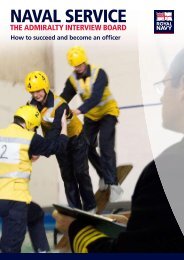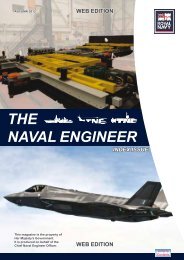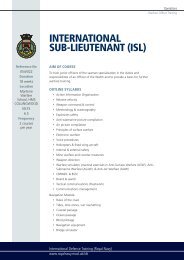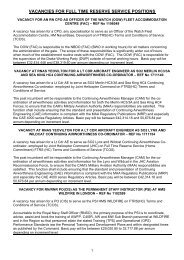THE NAVAL ENGINEER
THE NAVAL ENGINEER
THE NAVAL ENGINEER
Create successful ePaper yourself
Turn your PDF publications into a flip-book with our unique Google optimized e-Paper software.
5<br />
weather and the lack of the<br />
Glideslope.<br />
• Following a lengthy absence<br />
from work. The Captain of<br />
Flight 801 hadn’t flown into<br />
Guam for a month.<br />
• When handovers are between<br />
experienced and inexperienced<br />
staff. While the crew on<br />
Flight 801 were experienced,<br />
their cultural background, as<br />
exemplified by their high PDI<br />
score, prevented then from<br />
having a questioning attitude<br />
and an open discussion.<br />
If this still seems entirely<br />
unambiguous and common sense,<br />
then why are the human error rates<br />
so high on Nuclear Propulsion<br />
Operating Standards Quarterly<br />
Report of safety? Complacency<br />
can creep up in any profession.<br />
Nobody can sit back and think they<br />
are safe. The following sections list<br />
many of the tools and techniques<br />
used to improve information flow.<br />
Whilst these lists below might seem<br />
to be lists of the blindingly obvious,<br />
it is amazing how often they are not<br />
given sufficient attention.<br />
Hints for Handovers<br />
Communication can be written<br />
or verbal. An effective handover<br />
or pre-task brief sets the scene<br />
for subsequent actions. The HSE<br />
report “Effective Shift Handovers –<br />
a Literature Review” has some<br />
pertinent things to do. Compare the<br />
rest of Flight 801’s performance<br />
with best practice:<br />
• Logs up to date. Establish<br />
a thorough baseline. Flight<br />
801’s chart was out of date.<br />
• Have a procedure for<br />
handovers/briefs and follow<br />
it. Korean Airlines does have a<br />
standard procedure for descent<br />
briefs but the Captain didn’t<br />
follow it.<br />
• Have accurate carry forward<br />
of written information.<br />
• Involve people working at the<br />
sharp end. The most effective<br />
interventions are those where<br />
operators are involved as they<br />
know the risks and hazards and<br />
can contribute to the debate.<br />
• Give shift handovers and<br />
briefs an effective priority.<br />
The Captain’s brief was too<br />
short.<br />
Improvements – Good<br />
Communications Tools and<br />
Techniques<br />
Below (Table 1) are some more<br />
tools and techniques to encourage<br />
good communications.<br />
When it comes to<br />
communication, engineers<br />
are their own worst<br />
enemy 4<br />
Studies have demonstrated<br />
or observed that the culture<br />
of engineering impedes the<br />
collaborative processes in<br />
team work and hinders good<br />
communications 5 . This seems to<br />
be a truism across a wide variety<br />
of engineering disciplines and from<br />
different cultural backgrounds 6 .<br />
Engineers come in many shapes<br />
and sizes (and WEs) and have<br />
been labelled amongst others as<br />
4. Paul Leonardi, The Mythos of<br />
Engineering Culture.<br />
5. Amongst others Ingram, S. & Parker, A.<br />
(2002) The influence of gender on<br />
collaborative projects in an engineering<br />
classroom. IEEE Transactions on<br />
Professional Communications, 45(1), 7-20.<br />
6. Barley, S.R. (1996) Technicians in the<br />
Workplace: Ethnographic Evidence for<br />
Bringing Work into Organizational Studies<br />
Administrative Science Quarterly 41(3), 404-441.<br />
the creator (an artificer), geeks (Bill<br />
Gates), the maverick (a technology<br />
tinkerer) and the expert (any<br />
engineer)! Engineers are also seen<br />
as macho, with a competitive streak.<br />
Whilst this latter label may seem too<br />
strong, many studies have shown<br />
that engineers thrive in the mastery<br />
of their craft and the fact that they<br />
‘get it’ and grasp new concepts<br />
faster than others. Engineers also<br />
thrive in putting others down and<br />
competitively demonstrating their<br />
mastery to others. If you think this<br />
view is too extreme, think about<br />
the RN push for professional<br />
recognition, encouragement for<br />
master’s level studies, the questions<br />
on our professional boards, the<br />
way we grade ourselves and our<br />
technical back-bar talk.<br />
Unfortunately technology bias<br />
has other consequences. In<br />
demonstrating the mastery of their<br />
art, engineers are likely to assert<br />
their professional opinions 7 . The<br />
more strongly that opinions are<br />
voiced, the less likely it is that<br />
subordinates and peers will to voice<br />
their own opinions, defying one<br />
of the basic ingredients of team<br />
successes – namely openness. On<br />
Flight 801, whilst the Captain wasn’t<br />
an engineer, after he voiced his<br />
strong opinions no-one was likely to<br />
challenge him. Such an impact was<br />
seen during the Fukushima Event,<br />
when it is a matter of record that the<br />
Japanese Prime Minister was giving<br />
technical orders to those working<br />
on minimising the effects of core<br />
meltdown.<br />
The second consequence of<br />
this fixation with the mastery of<br />
the engineering art is that team<br />
members are picked solely on<br />
their technical competence. For<br />
7. La Fasto, F.& Larson, C. (2001) When<br />
Teams Work Best: 6,000 Team Members<br />
and Leaders Tell What it Takes to Succeed.<br />
Thousand Oaks, CA: Sage.<br />
Speak Up Encourage the Team Communicate Openly<br />
Who? Everyone Supervisors Managers<br />
Time out for Safety Safety conversations and training Safety conversations and training<br />
Tool Box Talks Tool Box Talks Site visits<br />
Tools and<br />
Time for Health and Safety Observation and feedback Operators meetings<br />
Techniques<br />
Observations and feedback Staff briefings Staff meetings<br />
Peer reviews<br />
Table 1: Tools and techniques<br />
Jump to<br />
Contents

















